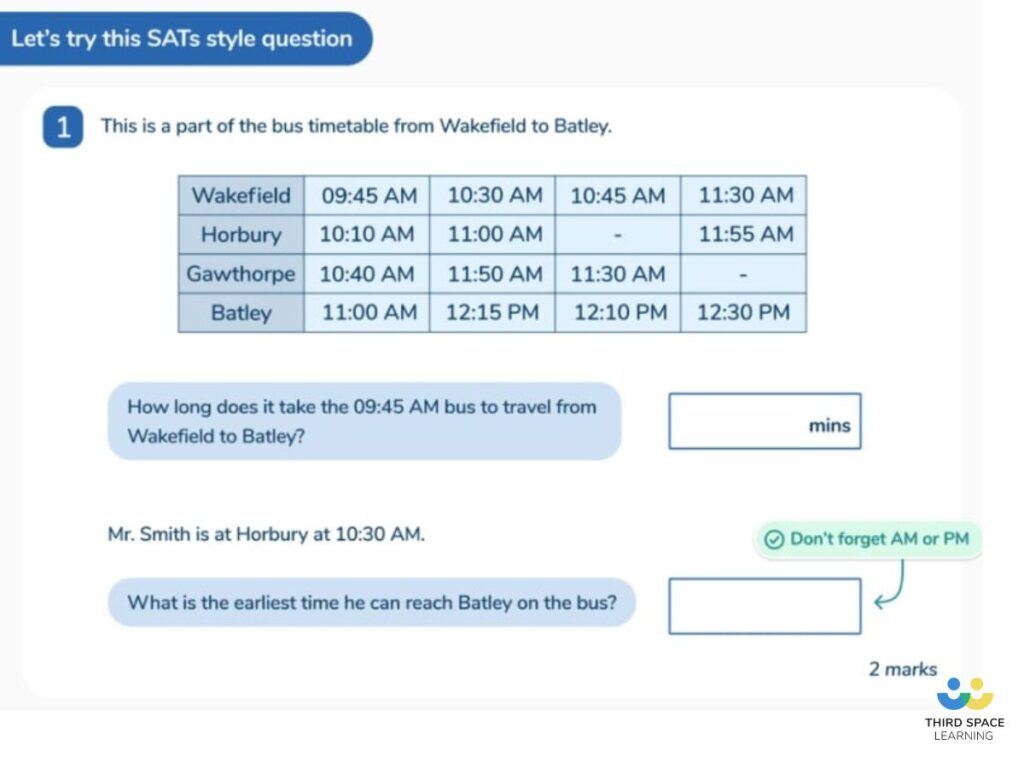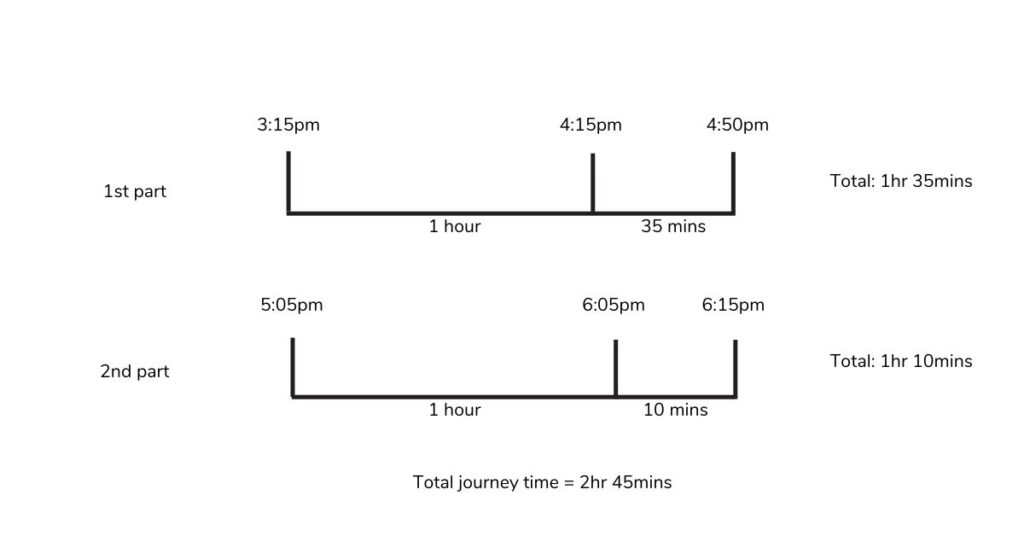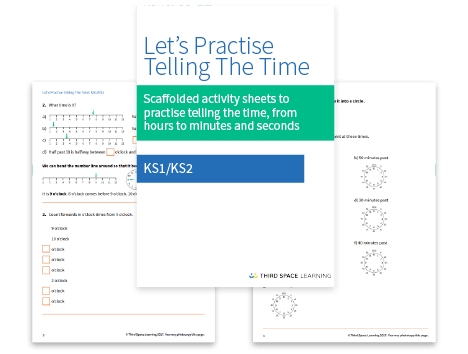25 Time Word Problems for Year 2 to Year 6 With Tips On Supporting Pupils’ Progress
Time word problems are an important element of teaching children how to tell the time. Children are introduced to the concept of time in Year 1. At this early stage, they learn the basics of analogue time; reading to the hour and half past and learn how to draw hands on the clocks to show these times.
As they move through primary school, pupils progress onto reading the time in analogue, digital and 24 hour clocks and being able to compare the duration of events. By the time children reach upper Key Stage 2, they should be confident in reading the time in all formats and solving problems involving converting between units of time.
- Time word problems in the National Curriculum
- Why are word problems important for children’s understanding of time
- How to teach time word problem solving in primary school
- Time word problems for year 2
- Time word problems for year 3
- Time word problems for year 4
- Time word problems for year 5
- Time word problems for year 6
- More time and word problems resources
Let's Practice Telling The Time
Download this free printable worksheet to let your students practice telling the time.
Download Free Now!When students are first introduced to time and time word problems, it is important for them to have physical clocks, to hold and manipulate the hands. Pictures on worksheets are helpful, but physical clocks enable them to work out what is happening with the hands and to solve word problems involving addition word problems and subtraction word problems.
Time word problems are important for helping children to understand how time is used in the real-world. We have put together a collection of 25 time word problems, which can be used with pupils from Year 2 to Year 6.
Time word problems in the National Curriculum
Time in Year 1
In Year 1, students are introduced to the basics of time. They learn to recognise the hour and minute hand and use this to help read the time to the hour and half past the hour. They also draw hands on clock faces to represent these times.
Time in Year 2
By the end of Year 2, pupils should be able to tell the time to five minutes, including quarter past/to the hour and draw the hands on a clock face to show these times. They should also know the number of minutes in an hour and the number of hours in a day.
Time in Year 3
In Year 3, children read the time in analogue (including using Roman Numerals). By this stage they are also learning to read digital time in 12 and 24 hour clock, using the AM and PM suffixes. Pupils record and compare time in terms of seconds, minutes and hours; know the number of seconds in a minute, days in a month and year and compare durations of events.
Time in Year 4
By Year 4, pupils should be confident telling the time in analogue to the nearest minute, digital and 24 hour clock. They also need to be able to read, write and convert time between analogue and digital 12 and 24 hour clocks and solve problems involving converting from hours to minutes; minutes to seconds; years to months and weeks to days.
Time in Year 5 & 6
By Year 5 and 6, there is only limited mention of time in the curriculum. Pupils continue to build on the knowledge they have picked up so far and should be confident telling the time and solving a range of problems, including: converting units of time; elapsed time word problems, working with timetables and tackling multi-step word problems.
Time word problems have been known to appear on Year 6 SATs tests. Third Space Learning’s online one-to-one SATs revision programme incorporates a wide range of word problems to develop students’ problem solving skills and prepare them the SATs tests. Available for all primary year groups as well as Year 7 and GCSE, our online tuition programmes are personalised to suit the needs of each individual student, fill learning gaps and build confidence in maths.

Why are word problems important for children’s understanding of time
Word problems are important for helping children to develop their understanding of time and the different ways time is used on an every-day basis. Confidence in telling the time and solving a range of time problems is a key life skill. Time word problems provide children with the opportunity to build on the skills they have picked up and apply them to real-world situations.
How to teach time word problem solving in primary school
It’s important children learn the skills needed to solve word problems. Key things they need to remember are: to make sure they read the question carefully; to think whether they have fully understood what is being asked and then identify what they will need to do to solve the problem and whether there are any concrete resources or pictorial representations which will help them.
Here is an example:
Mr Arrowsmith drives to Birmingham. He sets off at 3:15pm. He stops for a break of 15 minutes at 4:50 and arrives in Birmingham at 6:15pm.
How long did Mr Arrowsmith spend driving?
How to solve:
What do you already know?
- We know that he set off at 3:15pm and stopped for a break at 4:50. We can calculate how long the first part of his journey was, by counting on from 3:15 to 4:50.
- He had a break at 4:50pm for 15 minutes, so we won’t include that in our driving time calculation.
- He then must have set off again at 5:05pm, before arriving at 6:15pm. We can use this information to work out the length of the second part of his journey.
- We can then add the 2 journey times together, to calculate the total amount of time spent driving.
How can this be represented pictorially?

- We can use a number line to calculate the length of time each journey takes.
- If we start by adding on an hour, we can then calculate how many more minutes for each section of the journey.
- Once we have calculated the journey time for each part of the journey, we can add these together to calculate the total journey time.
Time word problems for year 2
Time word problems in Year 2 require students to read the time to o’clock and half past the hour and compare and sequence time intervals.
Question 1
Oliver went for a bike ride with his friend.
He left home at 2 o’clock and came home at 4 o’clock.
How long was he out on his bike for?
Answer: 2 hours
Count on from 2 o’ clock to 4 o’clock or subtract 2 from 4.
Question 2
Mum went shopping at 3 o’clock and got home an hour later.
Draw the time she got home on the clock below.
Answer

Question 3
Tom baked a cake.
The cake was in the oven for one hour.
If he took the cake out at half past 11, what time did he put the cake in?
Answer: Half past 10
Use an hour from half past 11.
Question 4
Arlo starts school at 9 o’clock and has his first break at half past 10.
How long does he have to wait for his first break?
Answer: One and a half hours.
(Use a number line to count on from 9 to half past 10)
Question 5
The Smith family are going to the beach.
They plan to leave home at 10 o’clock and the journey take two hours.
What time will they arrive at the beach?
Answer: 12 o’clock
(Use a number line to count on 2 hours from 10 o’clock)
Time word problems for year 3
With time word problems for year 3, students build on their understanding of analogue time from Year 2 and also begin to read the time in digital (12 and 24 hour clock). Children also need to be able to compare time and durations of events.
Question 1
Chloe is walking to football training.
She sets off at 8:40am and takes 17 minutes to get there.
What time does she arrive?
Answer: 8:57
(Count on 17 minutes from 8:40 – use a number line if needed)
Question 2
(Picture of analogue clock with 2:30 showing here)
Maisie says that in 1 hour and 48 minutes it will be 4:28.
Do you agree? Explain how you worked out your answer.
Answer: Maisie is wrong. It will be 4:18.
This can be worked out by counting on an hour from 2:30 to 3:30 and then another 48 minutes to 4:18.
Question 3
The Baker family are driving to their campsite.
They set off at 8:30 am, drive for 2 hours and 15 minutes, then had a 30 minute break.
If they drive for another 1 hour and 45 minutes, what time do they arrive at the campsite?
Answer: 12:45pm
Use a number line to show what time they arrive at the break. From 8:30, count on 2 hours and 15 minutes to get to 10:45. Add on the 30 minute break. It is now 11:15. They count on another hour and a half to 12:45
Question 4
Ahmed looks at his watch and says ‘it is half past 4 in the afternoon’
Jude says that it is 17:30 in a 24 hour clock.
Is Jude correct? Explain your answer.
Answer: Jude is not correct. Half past 4 in the afternoon is 16:30 not 17:30
Question 5
How many minutes are there in 2 hours and 30 minutes?
Answer: 150 minutes
60 + 60 + 30 = 150
Time word problems for year 4
When solving time word problems for year 4, pupils need to be confident telling time in analogue, and digital, as well as converting between analogue, 12 hour and 24 hour clock. They also begin to solve more challenging problems involving duration of time and converting time.
Question 1
If there are 60 seconds in 1 minute. How many seconds are there in 8 minutes?
Answer: 480 seconds
60 x 8 = 480 seconds (calculate 6 x 8, then multiply by 10)
Question 2
Mason played on his VR from 3:35 to 5:25.
How long did he play on his VR?
Answer: 1 hour and 50 minutes.
Count on from 3:35 (using a numberline if needed)
Question 3
Jamie started his homework at 3:45pm. He finished 43 minutes later.
What time did Jamie finish? Give your answer in 24 hour clock.
Answer: 16:28
Count on 43 minutes from 3:45 (use a number line, if needed) = 4:28. Convert to 24 hour clock.
Question 4
Chloe and Freya went to the cinema to watch a film. The film started at 2:05pm and lasted for 1 hour and 43 minutes.
What time did the film end?
Answer: 3:48pm
Count on one hour from 2:05 pm to 3:05pm, then add another 43 minutes – 3:48pm
Question 5
A family is driving on their holiday.
They drive for 2 hours and 28 minutes, stop for 28 minutes and then drive a further 1 hour and 52 minutes.
If they left at 8:30am, what time did they arrive?
Answer: 1:18pm
2 hours and 28 minutes from 8:30am = 10:58am
10:58am with a 28 minute break = 11:26am
1 hour 52 minute drive from 11:26 am = 1:18pm
Time word problems for year 5
With word problems for year 5, pupils should be confident telling the time in analogue and digital and solving a wider range of time problems including: converting units of time; interpreting and answering questions on timetables and elapsed time.
Question 1
The sun set at 19:31 and rose again at 6:28.
How many hours passed between the sun setting and rising again?
Answer: 10 hours and 57 minutes
Count on from 19:31 to 5:31 (10 hours)
Then count on from 5:31 to 6:28 (57 minutes)
Question 2
A play started at 14:45 and finished at 16:58.
How long was the play?
Answer: 2 hours and 13 minutes
Count on 2 hours from 14:45 to 16:45, then add another 13 minutes to get to 16:58
Question 3
How many seconds are there in 23 minutes?
Answer: 1380 seconds
Show as column method: 60 x 23 = 1380
Question 4
Max ran a race in 2 minutes 13 seconds, Oscar ran it in 125 seconds.
What was the difference in time between Max and Oscar?
Answer: Oscar was 8 seconds faster.
Max – 2 minutes 13 seconds, Oscar – 2 minutes 5 seconds (difference of 8 seconds)
Question 5
4 children take part in a freestyle swimming relay.
There times were:
Maisie: 42.8 seconds
Amber 36.3 seconds
Megan 48.7 seconds
Zymal 45.6 seconds
What was the final time for the relay in minutes and seconds?
Answer: 2:53.4
(Show as column method) 42.8 + 36.3 + 48.7 + 45.6 = 173.4 seconds
173.4 seconds = 2:53.4
Time word problems for year 6
No new time concepts are taught to pupils in word problems for year 6. By this stage they are continuing to build confidence and develop skills within the concepts already taught.
Question 1
Chess: 25 minutes
Basketball: 40 minutes.
Trampolining: 30 minutes
Gymnastics: 50 minutes
Tennis 40 minutes
Tri golf – 45 minutes
Hamza is choosing activities to take part in at his holiday club.
The activities can’t add up to more than 2 hours.
Which 3 activities could he do, which add up to exactly 2 hours?
Answer: Trampolining, gymnastics and tennis: Trampolining: 30 minutes, gymnastics: 50 minutes, tennis: 40 minutes.
Question 2
5 children took part in a sponsored swim. The children swam for the following lengths of time:
Sam: 27 minutes 37 seconds
Jemma: 33 minutes 29 seconds.
Ben: 23 minutes 18 seconds
Lucy: 41 minutes 57 seconds
Oliver: 39 minutes 21 seconds
Answer: 18 minutes 30 seconds
Longest: Lucy: 41 minutes 57 seconds
Shortest: Ben: 23 minutes 18 seconds.
Difference – count up from 23 minutes 18 seconds to 41 minutes 57 seconds = 18 minutes 39 seconds
Question 3
What is 6 minutes 47 seconds in seconds?
Answer: 407 minutes
60 x 6 = 360
360 + 47 = 407 minutes
Question 4
Bethany’s goal is to run round her school running track in under 8 minutes.
She runs it in 440 seconds. Does she achieve her goal? How far above or below the target is she?
Answer: Bethany beats her target by 40 seconds
8 minutes = 8 x 60 = 480 minutes
Question 5
Lucy’s favourite programme is on TV twice a week for 35 minutes.
In 6 weeks, how many hours does Lucy spend watching her favourite programme?
Answer: 7 hours
420 minutes = 7 hours
(Show as column method) 35 x 12 = 420 minutes
420 ÷ 60 = 7
More time and word problems resources
For more time resources, take a look at our collection of printable time worksheets. Third Space Learning also offers a wide collection of word problems covering a range of topics such as place value, decimals and fractions word problems, percentages word problems, division word problems, ratio word problems, addition and subtraction word problems, multiplication word problems, money word problems and other word problem challenge cards.
DO YOU HAVE STUDENTS WHO NEED MORE SUPPORT IN MATHS?
Every week Third Space Learning’s specialist primary maths tutors support thousands of students across hundreds of schools with weekly online 1 to 1 maths lessons designed to plug gaps and boost progress.
Since 2013 these personalised one to one lessons have helped over 150,000 primary and secondary students become more confident, able mathematicians.
Learn how tutors develop pupils’ maths fluency or request a personalised quote for your school to speak to us about your school’s needs and how we can help.




